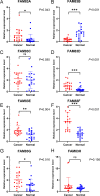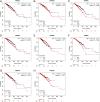Comprehensive analysis of the expression, prognostic significance, and function of FAM83 family members in breast cancer
- PMID: 35650627
- PMCID: PMC9158143
- DOI: 10.1186/s12957-022-02636-9
Comprehensive analysis of the expression, prognostic significance, and function of FAM83 family members in breast cancer
Abstract
Background: The FAM83 family plays a key role in tumorigenesis and cancer progression. However, the role of the FAM83 family in the development of breast tumors is unclear to date. This report explores the expression, prognostic significance, and function of the FAM83 family members in breast cancer using public databases.
Methods: UALCAN database was used to explore the expression of FAM83 family members in breast cancer. Furthermore, we validated the expression of FAM83 family members in twenty pairs of breast cancer and normal tissues by RT-PCR. Kaplan-Meier plotter database was used to explore the prognostic significance of FAM83 family members in breast cancer. GeneMANIA and DAVID databases were used for functional and pathway enrichment analysis of genes co-expressed with FAM83A, FAM83D, FAM83F, and FAM83G. MEXPRESS and UALCAN databases were used to analyze the level of DNA promoter methylation of FAM83A, FAM83D, FAM83F, and FAM83G in breast cancer. TIMER database was utilized to explore the relationships between immune cell infiltration and FAM83A, FAM83D, FAM83F, and FAM83G expression.
Results: Among FAM83 family members, FAM83A, FAM83D, FAM83F, and FAM83G were higher expressed in breast cancer than in normal tissues. We also validated the significant high expression of FAM83A, FAM83D, FAM83F, and FAM83G mRNA in breast cancer than in normal samples. Their increased expression has an adverse prognostic effect on breast cancer patients. These genes co-expressed with FAM83A, FAM83D, FAM83F, and FAM83G might take part in cell proliferation, G2/M transition of the mitotic cell cycle, regulation of apoptosis process and other cancer-related biological processes. In addition, they were mainly enriched in the Hippo signaling pathway, Hedgehog signaling pathway, PI3K/AKT signaling pathway, and other cancer-related pathways. We also found that promoter DNA methylation might regulate the expression of FAM83A, FAM83D, FAM83F, and FAM83G mRNA in most CpG islands. At last, we found the expression of FAM83A, FAM83D, FAM83F, and FAM83G mRNA was significantly related to immune cell infiltration.
Conclusions: FAM83A, FAM83D, FAM83F, and FAM83G were highly expressed in breast cancer tissues and had an adverse effect on the survival outcomes of breast cancer patients. Also, they were involved in breast cancer-related signal pathways. Therefore, they might serve as potential therapeutic targets for breast cancer clinical treatment.
Keywords: Breast cancer; FAM83 family; Therapeutic targets.
© 2022. The Author(s).
Conflict of interest statement
The authors declare that they have no competing interests.
Figures







Similar articles
-
Involvement of FAM83 Family Proteins in the Development of Solid Tumors: An Update Review.J Cancer. 2023 Jun 26;14(10):1888-1903. doi: 10.7150/jca.83420. eCollection 2023. J Cancer. 2023. PMID: 37476189 Free PMC article. Review.
-
Comprehensive Analysis and Identification of Prognostic Biomarkers and Therapeutic Targets Among FAM83 Family Members for Gastric Cancer.Front Cell Dev Biol. 2021 Nov 19;9:719613. doi: 10.3389/fcell.2021.719613. eCollection 2021. Front Cell Dev Biol. 2021. PMID: 34869310 Free PMC article.
-
Identification of Prognostic and Therapeutic Biomarkers among FAM83 Family Members for Pancreatic Ductal Adenocarcinoma.Dis Markers. 2021 Mar 1;2021:6682697. doi: 10.1155/2021/6682697. eCollection 2021. Dis Markers. 2021. PMID: 33747255 Free PMC article.
-
Identification of Prognostic Biomarkers Among FAM83 Family Genes in Human Ovarian Cancer Through Bioinformatic Analysis and Experimental Verification.Cancer Manag Res. 2021 Nov 15;13:8611-8627. doi: 10.2147/CMAR.S328851. eCollection 2021. Cancer Manag Res. 2021. PMID: 34815715 Free PMC article.
-
Sense and anti-sense: Role of FAM83A and FAM83A-AS1 in Wnt, EGFR, PI3K, EMT pathways and tumor progression.Biomed Pharmacother. 2024 Apr;173:116372. doi: 10.1016/j.biopha.2024.116372. Epub 2024 Mar 2. Biomed Pharmacother. 2024. PMID: 38432129 Review.
Cited by
-
Upregulation of FAM83F by c-Myc promotes cervical cancer growth and aerobic glycolysis via Wnt/β-catenin signaling activation.Cell Death Dis. 2023 Dec 16;14(12):837. doi: 10.1038/s41419-023-06377-9. Cell Death Dis. 2023. PMID: 38104106 Free PMC article.
-
Zebrafish reveal new roles for Fam83f in hatching and the DNA damage-mediated autophagic response.Open Biol. 2024 Oct;14(10):240194. doi: 10.1098/rsob.240194. Epub 2024 Oct 23. Open Biol. 2024. PMID: 39437839 Free PMC article.
-
Involvement of FAM83 Family Proteins in the Development of Solid Tumors: An Update Review.J Cancer. 2023 Jun 26;14(10):1888-1903. doi: 10.7150/jca.83420. eCollection 2023. J Cancer. 2023. PMID: 37476189 Free PMC article. Review.
-
Identifying the driver miRNAs with somatic copy number alterations driving dysregulated ceRNA networks in cancers.Biol Direct. 2023 Nov 22;18(1):79. doi: 10.1186/s13062-023-00438-x. Biol Direct. 2023. PMID: 37993951 Free PMC article.
-
Diagnostic value of immune-related biomarker FAM83A in differentiating malignant from benign pleural effusion in lung adenocarcinoma.Discov Oncol. 2024 Jun 24;15(1):242. doi: 10.1007/s12672-024-01109-7. Discov Oncol. 2024. PMID: 38914812 Free PMC article.
References
MeSH terms
Substances
Supplementary concepts
Grants and funding
LinkOut - more resources
Full Text Sources
Medical

